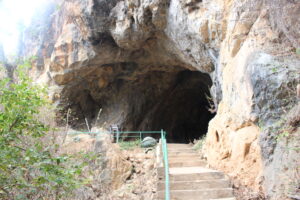Caves

Piew Cave
ThamPiew Cave stands as a solemn monument to hundreds of innocent villager killed in a 1968 us missile attack. Today, the statue of a man, straining to hold his anger as the carries a lifeless child, call for an “annual Day of Remembrance”. First, go to the visitor centre and contemplate the display of photographs and history behind the bombings. You’ll read about the single shell that his the core of Piu Cave and claimed the lives of a reported 374 locals seeking shelter inside. Then, climb the upper staircase, which passes a golden Buddha, grave markers, and bomb craters, until your reach ThamPiu, a sad hillside hole with the rubble floor. Inside, locals light incense to play tribute to the dead. Back outside, the stairs descent to small restaurants, which after a respite for reflection.
Location: Take Route 6 north from Kham town for 2 km to Ban Bouam, turn left (west), and follow to the road the end.

Thamxang Cave
Limestone peaks covered with forest s from the beautiful landscapes around the ThamXang Cave areas. Hidden in these rocks is a network of tree caves which was used by the PATHET LAO movement as shelter during the second Indochina War. Inside the cave complex they set up the hospital, an arsenal and drug depot. Evidence can st3ill be seen. Beside its war history the residential cave is worth visiting to see its gorgeous cave features.
Different dripstone features, called speleothems, can be seen inside. The most familiar formations are stalactites-handing downwards. And stalagmite-growing upwards. Sometime the drip water will flow down the walls and over the cave floor creating flowstone or rim stone deposits the from around pool of water like rice terrace. In some areas damage caused by humans, such as broken speleothems, which cannot be put back together, and graffiti at the walls, can be seen. (The Hmong community of Ban Ta take care of the caves and offers a local tour guide service).








 This Month : 50
This Month : 50 This Year : 12281
This Year : 12281 Total Users : 37362
Total Users : 37362 Views Today : 69
Views Today : 69 Total views : 70650
Total views : 70650 Who's Online : 1
Who's Online : 1